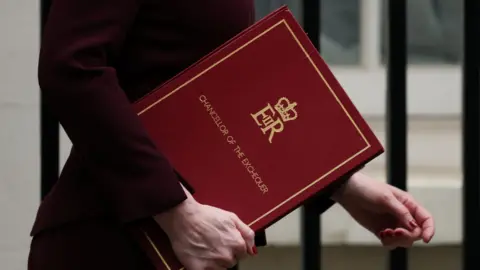Spring Statement 2025: Key points at a glance
 Reuters
ReutersChancellor Rachel Reeves has set out her plans for the UK economy during her Spring Statement in the House of Commons.
It came as the Office for Budget Responsibility (OBR) – which monitors the government’s spending plans – unveiled its latest economic forecasts.
Here is a summary of the main points.
Welfare changes
- Health-related universal credit for new claimants, which was already due to be halved from April 2026 under a package announced last week, will also now be frozen in cash terms until 2030
- The standard allowance for universal credit will now rise to £106 per week, instead of £107 per week in 2030
- As outlined last week, for existing claimants health-related payments will be frozen in cash terms until 2030
- There will also be a stricter eligibility test for personal independence payments (Pips), the main disability benefit, from November 2026
- Incapacity benefits to be frozen in cash terms for existing claimants at £97 per week from April next year, with a top-up payment for those with the most severe conditions
- Those aged under 22 will no longer be able to claim the incapacity benefit top-up of universal credit
Economic forecasts
- The Office for Budget Responsibility (OBR) has downgraded predicted growth for this year from 2% to 1%
- But it has upgraded estimated growth for the next four years, to 1.9% next year, 1.8% in 2027, then 1.7% in 2028 and 1.8% in 2029
- Inflation forecast to average 3.2% this year, up from 2.6% previously forecast, before falling back to 2.1 in 2026
- Inflation expected to hit 2% government target from 2027
- The OBR says changes to England’s planning system announced last year will boost housebuilding by 170,000 over five years, growing the size of the economy by 0.2%
Spending rules
- The OBR says that without action, the government would have been on course to miss its self-imposed rule to balance spending against taxes by 2030
- A £9.9bn financial buffer against this target set in October’s Budget has been wiped out, with the Treasury blaming higher debt costs
- Taking account of savings, the OBR now says there is a 54% chance this rule will be met in 2030, up slightly from a 51% likelihood in October
- The chance of meeting the government’s other main rule, that public debt is projected to be falling as a share of the economy, remains at 51%
Defence and overseas aid
- Defence spending, which had been due to rise £2.9bn next year, to increase by a further £2.2bn
- The Treasury says this will take military expenditure to 2.36% of national income next year, a “down payment” on plans to raise it to 2.5% by 2027
- Ministers say the spending will be funded by reducing overseas aid from 0.5% to 0.3% of gross national income in 2027, and from the Treasury’s reserves
Public services
- Target to reduce the administrative costs of government departments by 15% by 2030
- About 10,000 civil service jobs are expected to go, including staff working in HR, policy advice, communications and office management

Published at Wed, 26 Mar 2025 14:38:01 +0000

